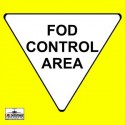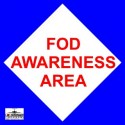Courtesy of USAF Flying Safety Magazine
Why It’s Important To Do A Thorough Intake Inspection: Part One
Mishap aircraft (MA) engine start, taxi, takeoff, flight and landing were uneventful for the twin- engine jet. Thruflight inspection revealed the MA had sustained a bird strike on the right side of the fuselage in front of the No. 2 engine. First stage fan blades did exhibit some damage, so the mishap engine (ME) was borescoped, and additional fan blades were found damaged. The ME was removed to the Propulsion Shop for further evaluation where it was discovered several blades in the high-pressure compressor had also suffered extensive damage. While installing the replacement engine, a piece of a coin – an ordinary piece of US pocket change – was found behind the MA. Propulsion top-halved the ME for additional inspection, compared the coin remnant to witness marks on the blades and decided the bird – unless he had been carrying change in a pocket – was guiltless in this instance of engine damage. Which leads to the following thoughts:
- If you do an intake inspection with loose items on your person, you’re going to FOD an engine – that could cost an aircraft and crewmembers’ lives.
- It’s impossible to over-estimate the value of a through intake inspection.
- If you ever DO come across a bird transporting coinage, be sure to notify the folks here at the AF Safety Center’s BASH Team. They’d like to see that for themselves!

Why It’s Important To Do A Thorough Intake Inspection: Part Two
The mishap Maintainer (MM) was detailed to work weekend duty and he was as busy as he had ever been, working to get an NMC jet fixed. Monday rolled around and he was still jumping, working the problem-NMC jet. The mishap aircraft (MA) had made its first flight of the day and, in-between turns, its Crew Chief discovered a couple of fan blade nicks that looked like possible candidates for blending. The Crew Chief notified his Expediter, who contacted the MM, who stopped work on his NMC jet. The MM checked out an engine blade blend kit and other gear necessary for evaluating the MA’s engine. The MM inspected the MA engine, determined the suspect nicks had been blended previously and were within serviceable limits. He exited the intake, documented the 781s accordingly and proceeded back to his problem-child aircraft. Can’t say just how the sequence of events unfolded from there, but can pick it up from the point where the mishap pilot (MP) arrived at the MA. The MP reviewed the aircraft forms, noted the engine write-ups and performed a thorough walk-around, paying particular attention to the engine intake area. Satisfied all was well, he climbed in, strapped in and proceeded with engine start. Engine start sequence was fine until just before reaching idle RPM, when he heard a loud “Thump!” looked outside and saw a neighboring Crew Chief running his way giving him a visual to shut down the engine. The MP shut down IAW emergency procedures and deplaned. A quick look down the intake revealed extensive damage and a look behind the aircraft was just as chilling: In addition to engine parts, there were the remains of a two-cell, metallic flashlight.
More lessons learned?
- It’s impossible to over-estimate the value of a through intake inspection. (Sound familiar?)
- It’s impossible to over-estimate the value of a thorough CTK inventory before, during and after completing maintenance.
- The costs to repair the damage done by this two-cell metallic flashlight totaled more than $700 thousand. Ouch!



